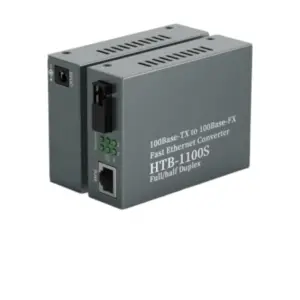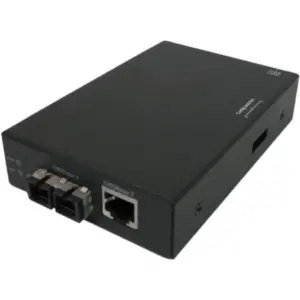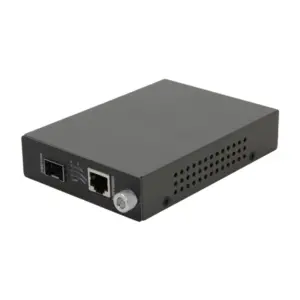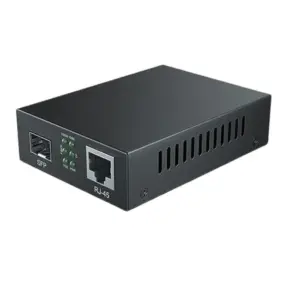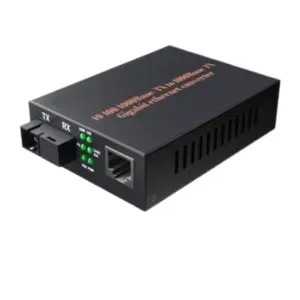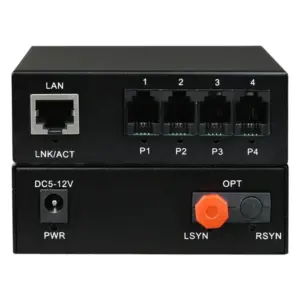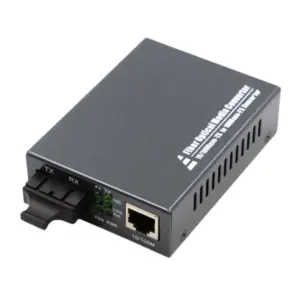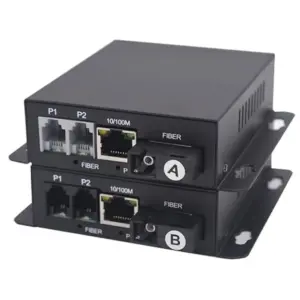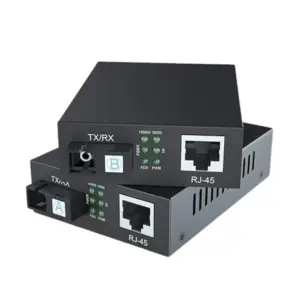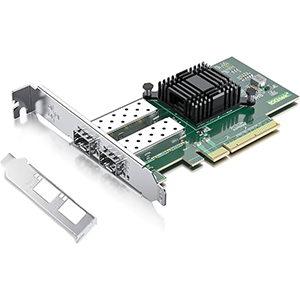Ethernet undoubtedly plays a key role in modern networks. This article will introduce Ethernet media converters and their functions. We will first define the working mechanism of Ethernet media converters and explain their role in Ethernet connections. Next, we will introduce common media converter classifications, such as optical-to-electrical conversion, electrical-to-electrical conversion, etc., and explain the physical interfaces and application scenarios of various types of converters.
We will explain in detail how media converters achieve interconnection between different physical interfaces and analyze the functions of key circuit components in the conversion process. In addition, we will list the key parameters that affect the conversion effect, such as bandwidth, latency, etc., and explain how to choose a suitable converter according to actual needs. Finally, we will introduce the application of media converters in wired network expansion, fiber access, etc., and analyze the role of converters in different scenarios.
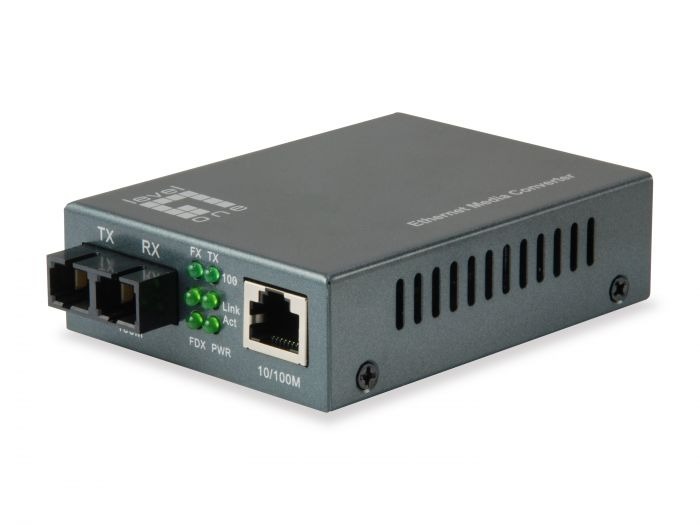
Overview of Ethernet Media Converters
Let me introduce you to the basic concepts of Ethernet media converters.
Working mechanism of Ethernet media converters:
An Ethernet media converter is a network device that is mainly used to connect different types of Ethernet interfaces to achieve network signal conversion and transmission. Specifically:
1. Interface type conversion:
- The media converter can connect Ethernet interfaces of different physical media types, such as optical fiber and copper cable.
- It can convert Ethernet signals of one media type into signals of another media type.
2. Signal conversion processing:
- The media converter contains corresponding circuits and chips inside, which can process physical layer signals of different media.
- It will perform appropriate amplification, shaping, encoding and other conversions on the received signal to adapt to the requirements of the target media.
3. Full-duplex communication:
- The media converter supports the full-duplex communication mode of Ethernet and can realize bidirectional data transmission.
- It will independently process the signal conversion in the upstream and downstream directions to ensure smooth transmission of data in both directions.
The role of Ethernet media converters in connection:
1. Connecting different media:
- Media converters can connect Ethernet devices that use different physical media, such as optical fiber and copper cable.
- It can make up for the signal incompatibility between these heterogeneous interfaces.
2. Extending transmission distance:
- Optical fiber can generally achieve Ethernet transmission over longer distances, while copper cable transmission distance is limited.
- In scenarios where the transmission distance needs to be extended, media converters can play a transit role.
3. Improving network performance:
- Different media types have different transmission characteristics, such as bandwidth, anti-interference, etc.
- Media converters can select media types with better performance and improve the transmission quality of the entire network.
In short, Ethernet media converters are key devices that connect different Ethernet interfaces and play an important role in network deployment and performance optimization.
Main types of Ethernet media converters
Let me introduce you to the main types of Ethernet media converters and their application scenarios in detail.
Common media converter classifications:
1. Optoelectronic converter:
- Converts optical fiber Ethernet signals into electrical signals (such as RJ-45 interface).
- Mainly used to connect optical fiber backbone networks and copper cable access networks.
2. Electrical-to-electrical converter:
- Converts between different types of cable Ethernet interfaces, such as RJ-45 and M12.
- Applied to connect copper cable devices of different standards, such as industrial control equipment.
3. Optical-to-optical converter:
- Realize signal conversion between different optical fiber types, such as single-mode fiber to multimode fiber.
- Applied to interconnect different transmission distances or bandwidth requirements in optical fiber networks.
4. Serial-to-parallel converter:
- Convert serial Ethernet signals to parallel signals, or vice versa.
- Used to connect devices with different Ethernet interfaces, such as industrial control systems.
Physical interfaces and application scenarios of various converters:
1. Optical-to-electrical converter:
- The optical fiber interface is usually FC, SC, LC, etc., and the cable interface is RJ-45.
- Applied to connect optical fiber trunk lines and copper cable access networks, such as FTTH, enterprise networks, etc.
2. Electric-to-electric converter:
- The cable interface can be different types such as RJ-45, M12, DB9, etc.
- Used to connect industrial equipment, surveillance cameras, etc. of different standards.
3. Optical-to-optical converter:
- The optical fiber interface can be single-mode (SM) or multi-mode (MM) optical fiber interface.
- Applied to extend the transmission distance of optical fiber networks and connect segments with different bandwidth requirements.
4. Serial-to-parallel converter:
- The serial interface is RS-232/485, and the parallel interface is RJ-45.
- Used to connect industrial control equipment, PLC and other systems with different Ethernet interfaces.
In short, Ethernet media converters are classified differently according to the interface type of the connected device and the network topology requirements. Reasonable selection of converters can achieve efficient interconnection between heterogeneous Ethernet devices.
Working principle of Ethernet media converters
Let me introduce you to the working principle of Ethernet media converters in detail.
How media converters achieve interconnection between different physical interfaces:
The core function of Ethernet media converters is to convert Ethernet signals of different physical media types to each other, thereby achieving interconnection and communication between heterogeneous interfaces. The specific working process is as follows:
1. Signal reception:
- A physical interface (such as optical fiber) of the converter receives the Ethernet data signal.
- The transceiver circuit of the interface converts the optical signal into an electrical signal and sends it to the internal processing.
2. Signal processing:
- The converter contains a dedicated signal processing circuit that can identify and process different types of Ethernet signals.
- The circuit module will amplify, filter, encode and process the received signal to meet the requirements of the target media.
3. Signal transmission:
- After internal processing, the converter will output the signal to another physical interface (such as copper cable).
- The transceiver circuit of the interface converts the electrical signal into the corresponding physical signal and sends it out.
Through the complete process of signal reception, processing and transmission, the media converter realizes the mutual conversion and interconnection between different Ethernet interfaces.
Functions of key circuit components in the conversion process:
1. Transceiver circuit:
- Responsible for converting different types of physical signals (light, electricity) to each other.
- Such as the photoelectric transceiver circuit of the photoelectric converter, and the cable transceiver circuit of the electrical-to-electric converter.
2. Signal processing circuit:
- Amplify, filter, encode and process the received Ethernet signal.
- Ensure that the converted signal meets the technical specifications of the target media.
3. Microcontroller unit:
- Responsible for controlling the entire conversion process and coordinating the work of various components.
- According to the detected signal conditions, adjust the conversion parameters to optimize performance.
4. Power management circuit:
- Provide stable working power for each module of the converter.
- Ensure that the converter can operate reliably and resist power interference.
In short, Ethernet media converters achieve efficient conversion and interconnection between different Ethernet physical interfaces through key components such as transceiver circuits, signal processing circuits, and microcontrollers.
Main performance indicators of Ethernet media converters
Let me introduce you in detail the main indicators that affect the performance of Ethernet media converters, and how to choose a suitable converter according to actual needs.
Key performance indicators of media converters:
1. Bandwidth:
- The maximum transmission bandwidth supported by the converter directly determines the transmission speed of the network.
- It needs to match the bandwidth requirements of the connected devices and networks.
2. Delay:
- The additional delay introduced during the conversion process will affect the real-time performance of the network.
- For applications with high latency requirements, it is necessary to select a converter with lower latency.
3. Compatibility:
- The converter needs to support various common Ethernet physical interface standards.
- Ensure that it can be interconnected with existing devices without additional modification.
4. Power consumption:
- The power consumption level of the converter will affect the energy consumption and heat dissipation requirements of the device.
- In some power-sensitive scenarios, a low-power converter needs to be selected.
5. Reliability:
- The working stability and service life of the converter are important considerations.
- It is necessary to select a converter product with reliable quality and protection function.
Choose a suitable converter according to actual needs:
1. Network bandwidth requirements:
- If high-speed Ethernet transmission is required, a converter that supports gigabit bandwidth should be selected.
- For low-speed applications, a converter with 100M bandwidth can be selected to reduce costs.
2. Delay sensitivity:
- For applications with high real-time requirements, a converter product with low delay should be selected.
- For scenarios with low delay requirements, the cost factor can be appropriately weighed.
3. Physical interface type:
- It is necessary to determine the Ethernet interface type of the connected device in advance and select a matching converter.
- Make sure the converter has the required fiber and cable interface types.
4. Environmental adaptability:
- If the application scenario has special requirements for temperature, humidity, EMI, etc., choose an industrial-grade converter.
- For ordinary office environments, commercial-grade converter products can be selected.
In short, when choosing an Ethernet media converter, it is necessary to comprehensively consider multiple factors such as network performance, interface compatibility, and environmental adaptability, so as to select the converter product that best suits the actual application needs.
Typical application scenarios of Ethernet media converters
Okay, let me introduce you in detail the typical scenarios of Ethernet media converters in actual applications and their role.
Wired network extension application:
1.Scenario description:
- In an enterprise or campus environment, it is necessary to extend the limited distance copper cable Ethernet to a farther area.
- At the same time, it is also necessary to connect different types of Ethernet devices, such as switches, routers, etc.
2.The role of media converter:
- Using fiber media converter, copper cable Ethernet signals can be converted into optical signals for transmission.
- Fiber optics have a longer transmission distance, which is conducive to expanding network coverage.
- At the same time, the converter can connect different types of Ethernet devices to achieve heterogeneous interconnection.
Fiber optic access application:
1.Scenario description:
- InIn the access network, the backbone network uses high-speed optical fiber, while the user side uses copper Ethernet.
- Signal conversion is required between optical fiber and copper cable to achieve fiber-to-the-home (FTTH).
2. The role of media converters:
- The optical-to-electrical converter can convert optical Ethernet signals into electrical signals to connect user devices.
- Ensure high-speed interconnection and data transmission between the optical fiber backbone network and the copper cable access network.
- Simplify the deployment of user-side equipment and reduce dependence on optical fiber technology.
Industrial automation applications:
1. Scenario description:
- In industrial sites such as factories and power plants, Ethernet needs to be connected to different automation equipment.
- These devices may use different Ethernet physical interfaces, such as RJ-45, M12, etc.
2. The role of media converters:
- Electrical converters can convert different types of cable Ethernet interfaces to each other.
- Realize the interconnection between industrial control equipment, PLC, SCADA systems, etc.
- Simplify industrial field wiring and improve the flexibility of system integration.
In summary, Ethernet media converters play an important role in network expansion, fiber access and industrial automation. It can solve the compatibility problems between heterogeneous Ethernet devices and promote efficient interconnection between different network environments.
Summary
As a key component of network connection, the performance and reliability of fiber optic converter directly affect the stable operation of the entire system. Our company has long focused on the research and development and production of Ethernet equipment and its supporting products, and has rich industry experience. Our media converter products have reached the industry-leading level in key indicators such as bandwidth and power consumption, and can meet your demanding network application needs.
Whether you need to deploy in a wide area network environment or an industrial automation system, we can provide you with customized media converter solutions. At the same time, our professional team will provide you with a full range of technical support, including on-site surveys, performance testing, daily maintenance and other services. Contact us now to learn more about Ethernet media converters.
Ethernet Media Converters FAQ
An Ethernet media converter is a device that enables the interconnection between different Ethernet physical layer technologies, such as converting between copper-based Ethernet and fiber optic Ethernet.
The primary function of an Ethernet media converter is to convert the electrical signals in copper Ethernet cables to optical signals in fiber optic cables, and vice versa.
The media converter contains optical-to-electrical and electrical-to-optical conversion circuits that translate the data between the two different media types while maintaining the Ethernet protocol.
Common types include copper-to-fiber, fiber-to-fiber, and even media converters that can handle multiple Ethernet physical layer interfaces.
Typical components include optical transceivers, power supply, signal conditioning circuits, and a microcontroller for managing the conversion process.
Key advantages include the ability to extend the reach of Ethernet networks, connect disparate Ethernet segments, and leverage the benefits of fiber optic cabling.
Ethernet media converters can support a wide range of Ethernet standards, including 10/100 Mbps Fast Ethernet, Gigabit Ethernet, and even 10 Gigabit Ethernet.
Installation typically involves connecting the copper Ethernet and fiber optic cables, powering on the device, and potentially configuring network settings.
Troubleshooting may involve checking cable connections, power supply, LED status indicators, and ensuring compatibility between the converter and network equipment.
Advancements include support for higher Ethernet speeds, enhanced diagnostics, and the integration of additional features like PoE (Power over Ethernet) support.


